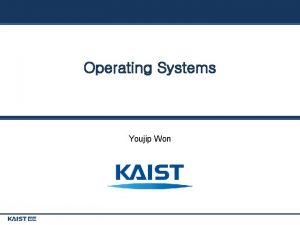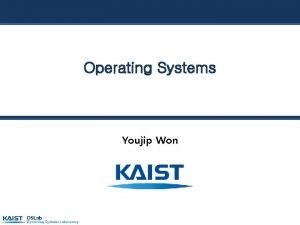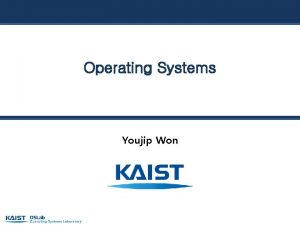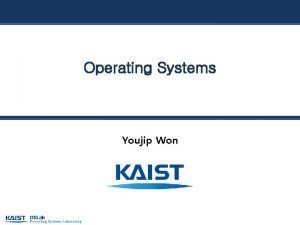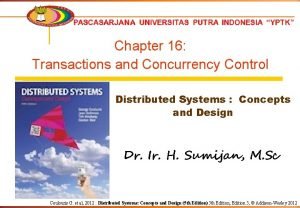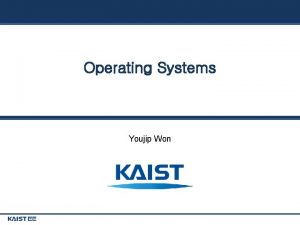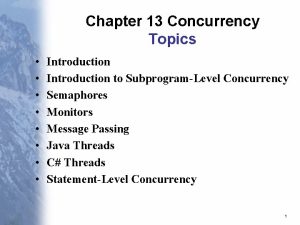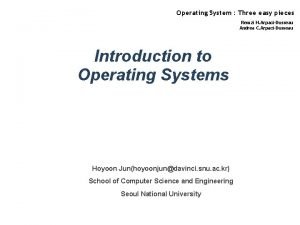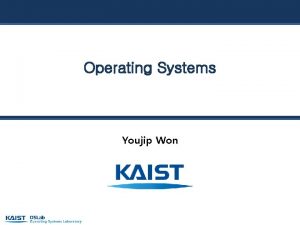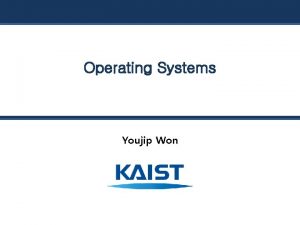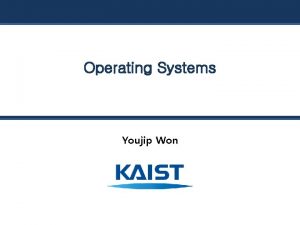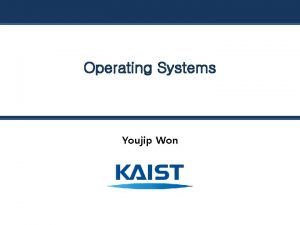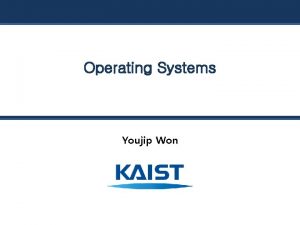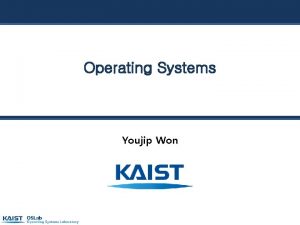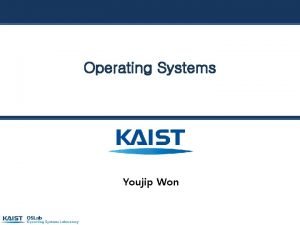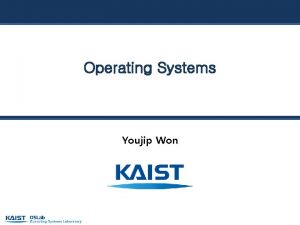Operating Systems Youjip Won 26 Concurrency An Introduction














- Slides: 14

Operating Systems Youjip Won

26. Concurrency: An Introduction Youjip Won 2

Thread A new abstraction for a single running process Multi-threaded program A multi-threaded program has more than one point of execution. Multiple PCs (Program Counter) They share the same address space. Youjip Won 3

Context switch between threads Each thread has its own program counter and set of registers. One or more thread control blocks(TCBs) are needed to store the state of each thread. When switching from running one (T 1) to running the other (T 2), The register state of T 1 be saved. The register state of T 2 restored. The address space remains the same. Youjip Won 4

The stack of the relevant thread There will be one stack per thread. 0 KB 1 KB 2 KB Program Code Heap The code segment: where instructions live The heap segment: contains malloc’d data dynamic data structures (it grows downward) 0 KB 1 KB 2 KB Program Code Heap (free) Stack (2) 15 KB 16 KB Stack (1) (it grows upward) The stack segment: contains local variables arguments to routines, return values, etc. 15 KB 16 KB (free) Stack (1) Two threaded Address Space A Single-Threaded Address Space Youjip Won 5

Why Use Threads? Parallelism Single-threaded program: the task is straightforward, but slow. Multi-threaded program: natural and typical way to make programs run faster on modern hardware. Parallelization: The task of transforming standard single-threaded program into a program that does this sort of work on multiple CPUs. Avoid blocking program progress due to slow I/O. Threading enables overlap of I/O with other activities within a single program. It is much like multiprogramming did for processes across programs. Youjip Won 6

An Example: Thread Creation Simple Thread Creation Code (t 0. c) 1 2 3 4 5 6 7 8 9 10 11 12 13 14 15 16 17 18 19 20 21 22 23 #include #include <stdio. h> <assert. h> <pthread. h> “common. h” “common_threads. h” void *mythread (void *arg) { printf (“%sn”, (char *) arg); return NULL; } int main (int argc, char *argv[]) { pthread_t p 1, p 2; int rc; printf(“main: beginn”); Pthread_create(&p 1, NULL, mythread, “A”); Pthread_create(&p 2, NULL, mythread, “B”); // join waits for threads to finish Pthread_join(p 1, NULL); Pthread_join(p 2, NULL); printf(“main: endn”); return 0; } Youjip Won 7

Thread Trace (1) main Thread 1 Thread 2 starts running prints “main: begin” creates Thread 1 creates Thread 2 waits for T 1 runs prints “A” returns waits for T 2 runs prints “B” returns prints “main: end” Youjip Won 8

Thread Trace (2) main Thread 1 Thread 2 starts running prints “main: begin” creates Thread 1 runs prints “A” returns creates Thread 2 runs prints “B” returns waits for T 1 returns immediately; T 1 is done waits for T 2 returns immediately; T 2 is done prints “main: end” Youjip Won 9

Thread Trace (3) main Thread 1 Thread 2 starts running prints “main: begin” creates Thread 1 creates Thread 2 runs prints “B” returns waits for T 1 runs prints “A” returns waits for T 2 returns immediately; T 2 is done prints “main: end” Youjip Won 10

Race condition Increasing a value of a variable counter = counter + 1 105 108 113 mov 0 x 8049 a 1 c, %eax add $0 x 1, %eax mov %eax, 0 x 8049 a 1 c Youjip Won 11

Race condition Example with two threads counter = counter + 1 (default is 50) We expect the result is 52. However, OS Thread 1 Thread 2 before critical section mov 0 x 8049 a 1 c, %eax add $0 x 1, %eax interrupt save T 1’s state restore T 2’s state mov 0 x 8049 a 1 c, %eax add $0 x 1, %eax mov %eax, 0 x 8049 a 1 c interrupt save T 2’s state restore T 1’s state mov %eax, 0 x 8049 a 1 c Youjip Won (after instruction) PC %eax counter 100 105 108 0 50 51 50 50 50 105 108 113 0 50 51 51 50 50 50 51 108 113 51 51 50 51 12

A few terminologies Race condition: the results depend on the timing execution of the code. Result is indeterminate. Critical section A piece of code that accesses a shared variable and must not be concurrently executed by more than one thread. Multiple threads executing critical section can result in a race condition. Need to support atomicity for critical sections (mutual exclusion) Youjip Won 13

The wish for atomicity Ideal approach; make the increment as a single assembly instruction memory-add 0 x 8049 alc, $0 x 1 In general, we do not have such instruction. Instead, we use lock. Ensure that any such critical section executes as if it were a single atomic instruction (execute a series of instructions atomically). 1 2 3 4 5 lock_t mutex; . . . lock(&mutex); balance = balance + 1; unlock(&mutex); Youjip Won Critical section 14
 Youjip
Youjip Youjip
Youjip Youjip won
Youjip won Youjipp
Youjipp Transactions and concurrency control in distributed systems
Transactions and concurrency control in distributed systems Pessimistic concurrency control
Pessimistic concurrency control Youjip
Youjip What is dual mode in os
What is dual mode in os Subprogram level concurrency
Subprogram level concurrency An operating system example
An operating system example Evolution of operating systems
Evolution of operating systems Components of an operating system
Components of an operating system Component of operating systems
Component of operating systems Wsn operating systems
Wsn operating systems Arpaci dusseau operating systems
Arpaci dusseau operating systems
